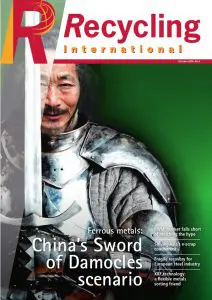Page 51 from: October 2014

51October 2014
E – s c r a p
– Financial resources and/or incentives are
inadequate.
– It has not been possible to unite all stakeholders
behind understanding and resolving problems.
– Most of the waste is in the hands of certain
groups where political will discourages trans-
formation.
– In some poor countries, there are not many
manufacturers active in the electrical and
electronic equipment sectors and so govern-
ments do not see a real need for regulatory
systems, even though post-consumer end-of-
life products are piling up.
– There is often confusion between federal and
state pollution control boards.
– And unlike in the EU and the USA, there is
no common e-scrap directive in Asia.
Complex knot
Many interest groups are currently discussing
Asia’s e-scrap problems, but unfortunately none
of them seem to be able to take ultimate respon-
sibility for providing the right environmentally
sustainable solutions. It is a complex knot which
will become increasingly difficult to untie.
Engineering change through shared responsi-
bility would represent a beneficial and sustain-
able solution. By engaging and formalising the
informal sector into a transparent recycling
system, it would be easier to control and regu-
late with regard to environmental and human
health impacts as well as to resource recovery.
The real problems for those in the informal
sector are job security, financial support and
social status. By joining their forces, it would
help to transform the informal e-scrap recy-
cling industry into a multi-stakeholder enter-
prise. It would be important to keep informal
operators in the front line of the formal system
and work towards more efficient collection. In
this scenario, the informal sector is crucial as it
has already established a vast network for cost-
effective collection of materials.
Need to act responsibly
All other stakeholders in the e-chain should act
responsibly to engage and transform the infor-
mal sectors, with key aspects being the collec-
tion, segregation, dismantling and transferring
of material to the formal sector for further
recovery and refining. The focus of this engage-
ment should be on:
– Involvement in policy decisions, together
with other stakeholders;
– Providing knowledge about environmental-
ly-sound recycling practices;
– Creating awareness and providing training
about hazardous substances and their impact;
– Transforming the knowledge and training
base to enhance collection, segregation and
dismantling efficiencies;
– Providing training through occupational
health and safety programmes, as well as provi-
sion of personal protective and safety devices;
– Providing social recognition, financial ben-
efits and a reliable, adequate income;
– Working closely with all stakeholders –
including producers, formal recyclers and
legislators – to achieve closed-loop systems;
– Providing the necessary documentation to
maintain control over traceability, accountabil-
ity and reporting to the regulatory authorities.
Co-operation between all actors in the chain is
essential and responsibilities should be shared
to enhance overall recycling performance.
Formal recycling companies must build the
necessary capacity and invest in technological-
ly-advanced recovery facilities. OEMs, bulk
consumers, industries and institutions must
take steps under their extended producer
responsibilities to ensure their e-scrap is being
properly collected, segregated and treated in an
environmentally-friendly way.
For their part, legislators and enforcement
officers will have to work closely with all stake-
holders in order to find a sustainable win-win
solution that takes account of the environment,
resource recovery and compliance with all the
regulatory standards.
Above all, a successful solution will depend on
a sharing of responsibility among regulators,
producers, the informal sector and also formal
recyclers.
State of confusion
In Asia, all stakeholders in the e-scrap chain are
currently in a state of confusion. It is very difficult
to invest money in Asia because the continent is,
in general, lacking: an appropriate legal frame-
work; financial support and incentives; regula-
tory enforcement; adequate extended producer
responsibility, corporate social responsibility and
public awareness; and a shared sense of responsi-
bility for finding sustainable solutions for e-scrap.
In some Asian countries, the authorities are not
able to frame stringent policies because they do
not have a good understanding of e-scrap.
However, experts’ knowledge and experience
can be harnessed to identify relevant policies
and possible synergies. In countries with vast
land areas such as China and India, e-scrap col-
lection systems will almost certainly involve
higher costs.
Meaningful change to the current situation can
be achieved through transformation of the
informal sector and co-operation among all
stakeholders. This transformation is not only
important for protecting the feedstock of formal
recyclers, but also for conserving resources.
Formal recycling companies must build the necessary capacity and
invest in technologically-advanced recovery facilities.
The lower labour costs in most developing nations makes the time-
intensive e-scrap recycling industry both viable and competitive.
Venkatesha Murthy
is the founder and
managing director of
VANS Chemistry in
Singapore and is a
member of the board
of directors of the
Sustainable Elec-
tronics Recycling coalition (SERI) in the
USA. He has more than 25 years of experi-
ence in e-scrap management and in the
recovery and refining of precious base met-
als. VANS Chemistry provides consultancy
and turnkey solutions for EEE-waste and
precious metals management including
metals recovery from recovery and refining
from many scraps. He can be reached at:
www.vanschemistry.com
RI8-Asia e-scrap.indd 51 07-10-14 10:25



